Freshwater anglers have lots of topwater options. In the bass game especially, those looking for surface eruptions can dip into practically any lure genre and find the perfect bait to call up a hog. Traditional Spooks and poppers are, of course, classics in sweetwater. But you’ve also got buzzbaits, prop baits, gurglers, crawlers, and an army of soft plastics designed to kick, sputter, and froth their way to big-fish victory. If you’re a saltwater angler, however, your choices are a bit more limited.
Years ago, I interviewed a captain from Louisiana who swore by hollow-body bass frogs for mahi-mahi. He would toss these weedless rubber baits over floating mats of sargassum seaweed and work them through the vegetation aggressively. It was a nifty — albeit niche — trick, but his success illustrates how saltwater predators aren’t usually as discerning as freshwater fish. A mahi doesn’t know what a frog is. It simply reacts to a moving target. In the salt, there is less need for finesse with topwaters, and choosing the right one for the situation hinges more on conditions than anything else.
Saltwater surface lures can be broken down into three main categories: poppers, walking baits, and sub-surface sliders. From offshore species like tuna to back bay redfish in skinny water, all three lure styles have a time and a place. So, let’s start by breaking down the benefits of each before diving into topwater tricks and techniques.
Poppers
- Best for deep water, stained water, choppy water.
Photo by Joe Cermele
Poppers are the most ubiquitous topwater in fishing. From creeks to the Gulf Stream, the chugging, spitting action of these lures draws attention from all manner of gamefish. They’re versatile, too. Regardless of how calm or choppy the surface conditions are, they’ll perform. The body shape and rear weighting of a popper also makes it very aerodynamic, so you can cast them far and accurately when a blitz erupts. Poppers can also be worked at any cadence. Chug them quickly to incite a reaction bite or gently pop and pause to keep them in the strike zone longer around sod banks, bridge pilings, and docks.
When buying poppers, pay attention to the depth of their scooped, concave mouths. The deeper the scoop, the more water it will gather and throw when you chug. This naturally makes deep-faced poppers louder. When chasing species like tuna and striped bass in deep, open water, this can be a huge benefit, as it can attract fish from greater distances. In shallow water, however, a popper with a less severe scoop can do a better job of mimicking a smaller injured baitfish flipping and flopping at the surface. They are also more effective when targeting fish holding and ambushing around inshore structure, where a subtler sound can be the ticket to drawing strikes.
Top Saltwater Poppers
MirrOlure Poppa Mullet
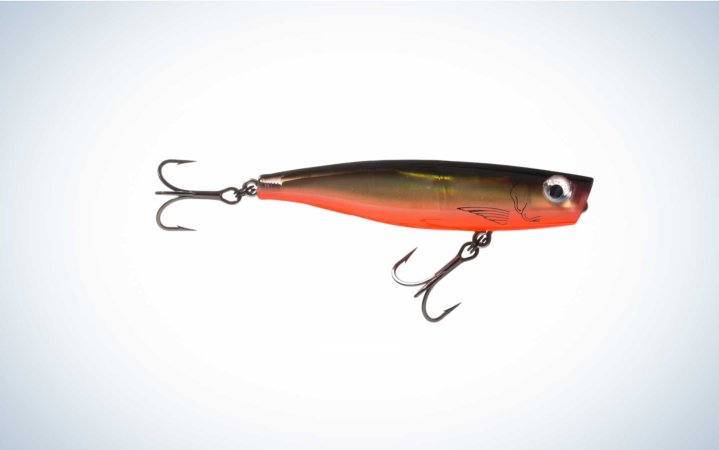
See It
Primary Targets: Redfish, seatrout, small snook, school-sized striped bass
With a slender profile and shallow popping mouth, this lure shines in skinny water where a subtler commotion makes the play.
Yo-Zuri Hydro Popper
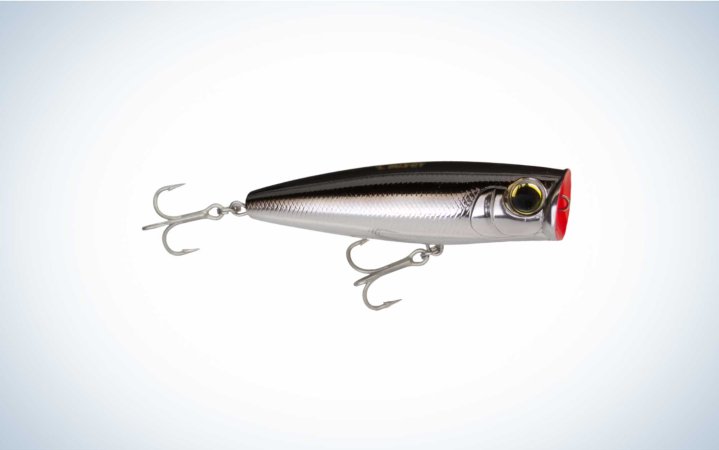
See It
Primary Targets: Striped bass, snook, bull redfish
A great all-around popper, this lure is strong enough to tangle with big fish as well as perform in open or sheltered waters.
Yo-Zuri Big Game Bull Popper
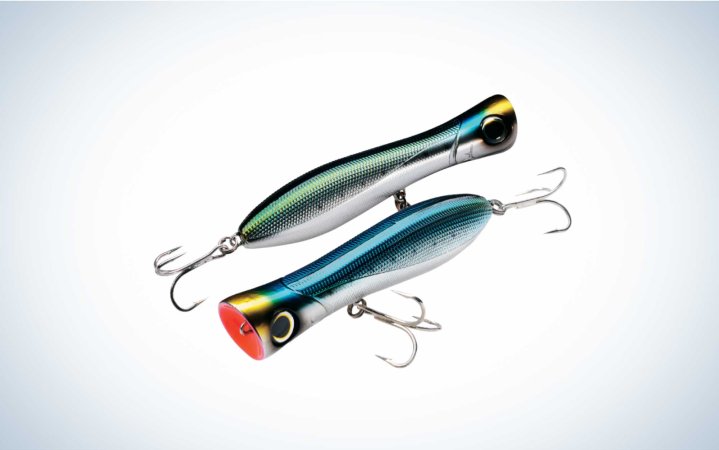
See It
Primary Targets: Tuna, mahi-mahi, trophy striped bass, bull redfish
With a loud chug, long casting distance, and extra-tough hardware, this popper can handle fish weighing north of 100 pounds.
Walking Baits
- Best for calm water, shallow water, and low light conditions
The most famous walking topwater of all time is the Heddon Zara Spook. It’s been around for nearly a century, and it’s responsible for the entire category of walking surface lures being collectively referred to as “Spooks.” These simple, cigar-shaped baits “walk” from side to side in a zig-zag pattern during the retrieve. Most also feature an internal rattle chamber that gives them a distinct “clacking” sound as they move. Though they’ll certainly produce when you inject subtle movements and pauses into the retrieve, it’s the rhythmic, repetitive sound on the surface that arguably draws the most strikes.
Spooks are the number one choice for seatrout anglers in back bay environments, as these fish feed heavily by sound. Of course, redfish, snook, and striped bass will also hammer them. Over the last few years, giant walking topwaters adopted from the muskie scene have been gaining popularity with saltwater anglers targeting big fish in deep, open water.
The one drawback of a Spook is that it’s difficult to maintain that steady, rhythmic cadence when surface conditions are rough. Wave action can make a Spook jump out of the water instead of gliding back and forth, which can mar the presentation.
Top Walking Baits for Saltwater
Heddon Zara Spook
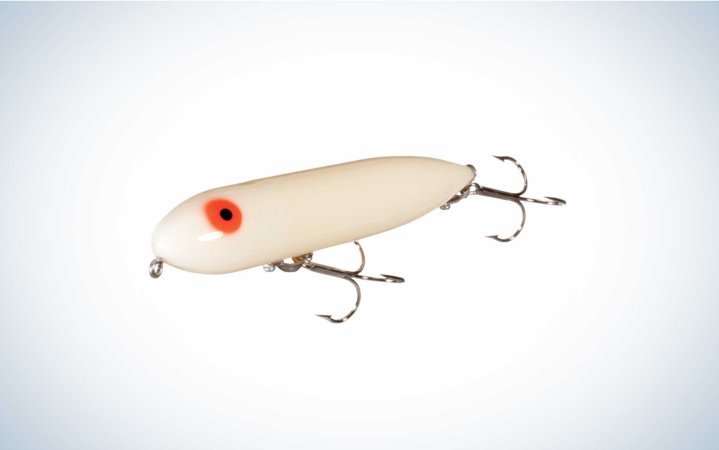
See It
Primary Targets: Seatrout, redfish, snook, striped bass
It’s hard to beat the old-school Zara in plain Bone color for practically any skinny-water species that eats baitfish.
MirrOlure Top Dog
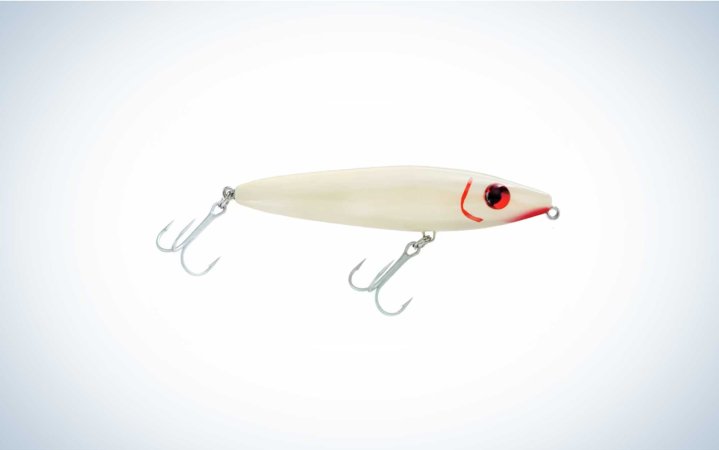
See It
Primary Targets: Seatrout, snook, redfish
Hugely popular across the South, the Top Dog has long been a staple in the boxes of wading anglers and boaters from Texas to Florida to the Carolinas.
Jigging World Doc
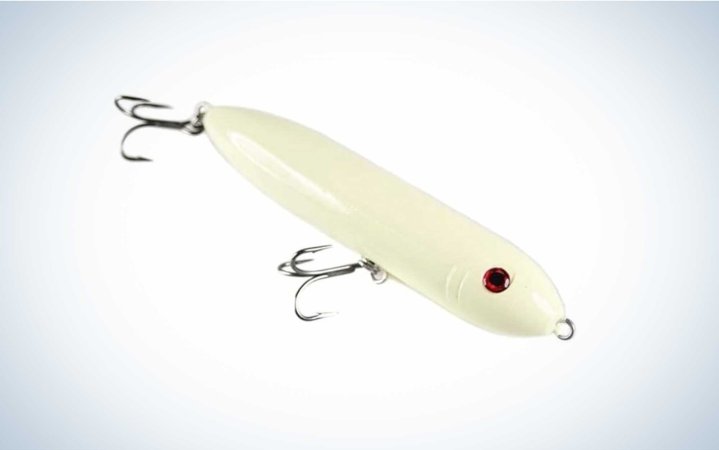
See It
Primary Targets: Trophy striped bass, bull redfish
This oversized, bone-colored Spook has the uncanny ability to make huge striped bass appear out of nowhere, even in the open ocean.
Sub-Surface Sliders
- Best for clear water, bright conditions, skittish fish
The slider category is odd because it encompasses several styles of lure including suspending twitchbaits. Are these surface lures? Yes and no. They’re designed to be fished just under the top, usually a foot or less deep. In most cases, they’re close enough that when you get smashed, it’s still very visual and results in a boil or vacuum hole where the lure used to be.
These kinds of lures shine on days when you’re seeing fish follow poppers and Spooks without committing. Reasons for this can vary, but it’s often during bright days, or when the water is ultra-clear, or a combination of both. The fish are being triggered by surface activity but not willing to close the deal up top. When this happens, the darting, slashing, bulging action of a slider just below the surface often makes the difference.
Top Sliders for Saltwater
Mirrolure MirrOdine
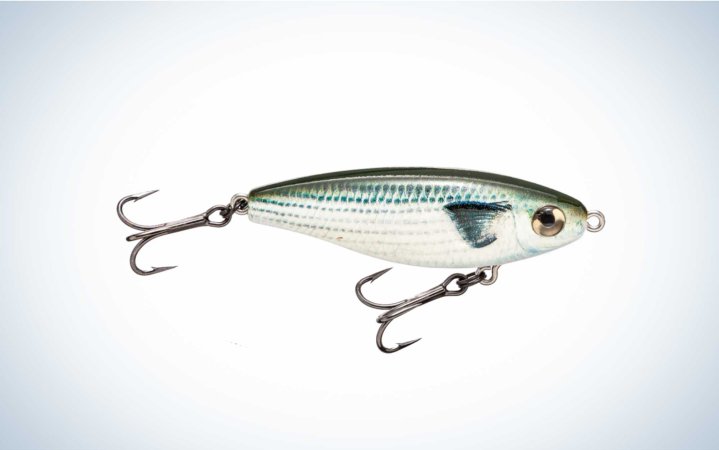
See It
Primary Targets: Seatrout, snook, redfish
With a maximum sink depth of only two feet, this bait is easy to keep just below the surface when retrieved with a high rod angle.
Rapala X-Rap Twitchin’ Minnow
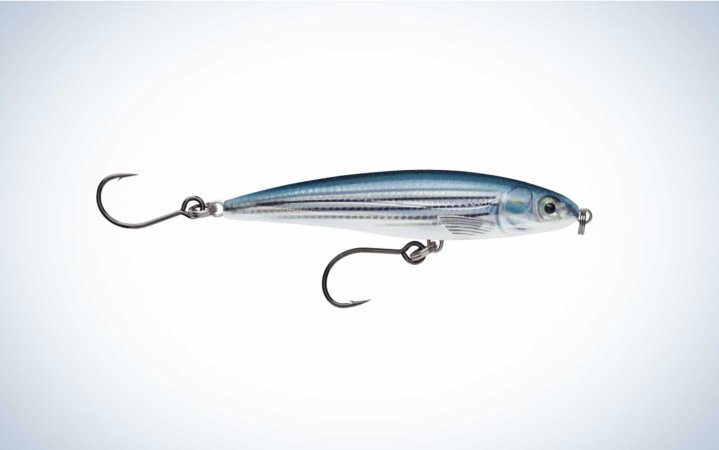
See It
Primary Targets: Snook, seatrout, striped bass
Two heavy-gauge single hooks help this lure stay pinned when big stripers or snook take a shot just under the surface.
Shimano Orca
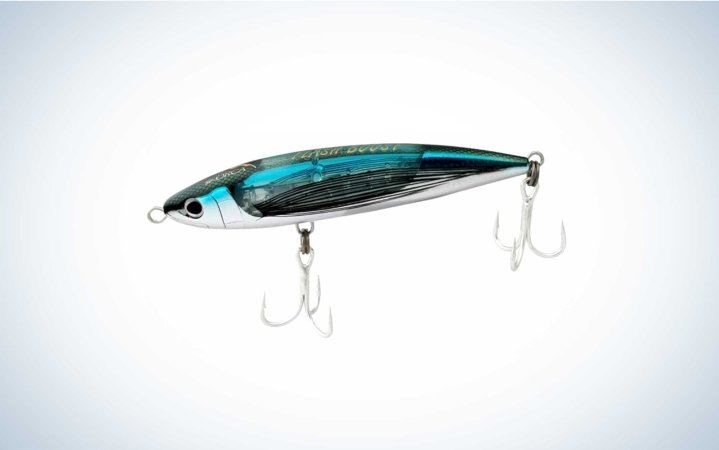
See It
Primary Targets: Tuna, mahi-mahi, trophy striped bass, trophy snook
With an ultra-slow sink rate and heavy-duty components, this lure can handle the giants that can’t resist its erratic slashing action.
Topwater Tips & Tricks
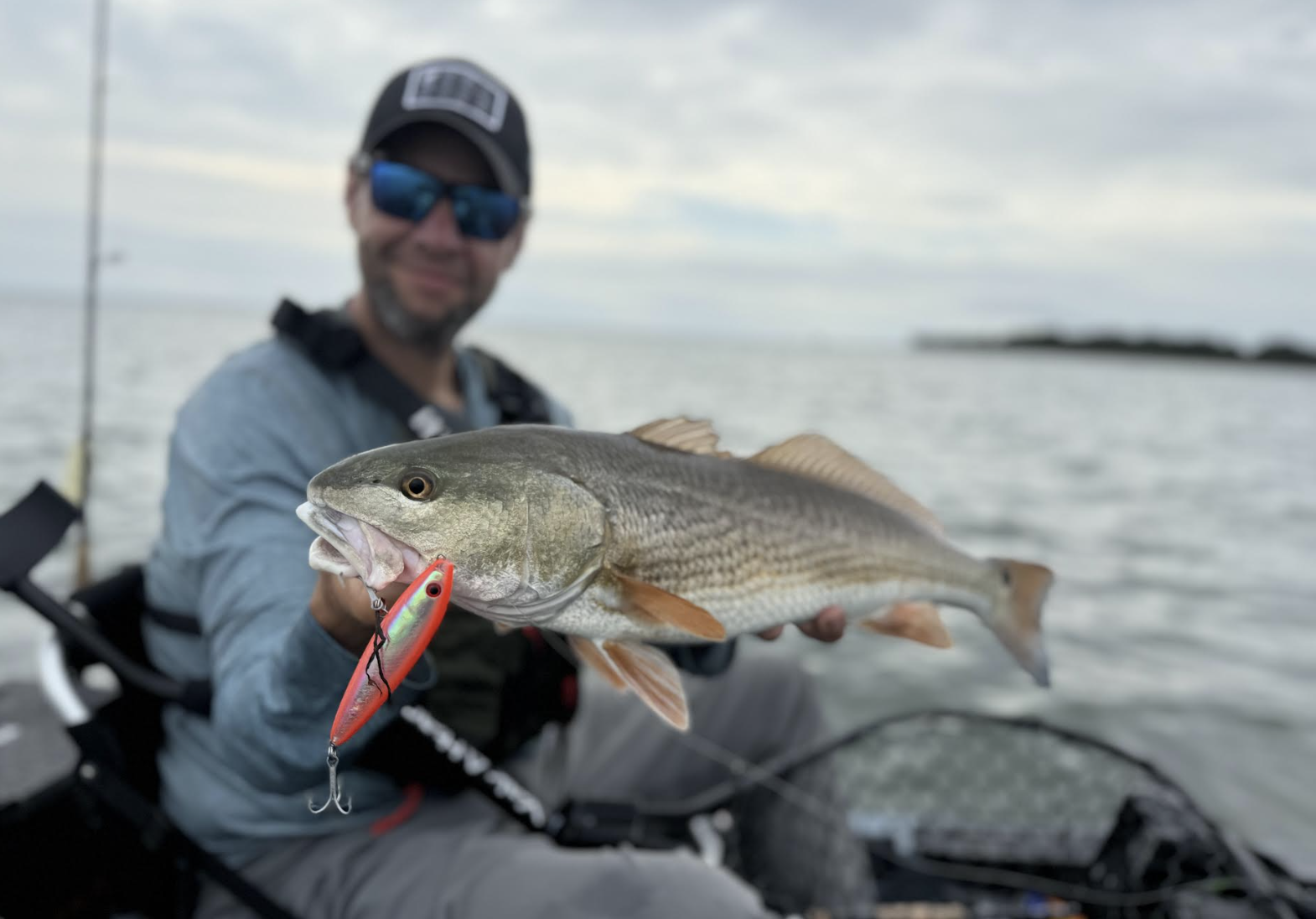
Photo by Joe Cermel
Do the Popper Drop-Back
Species like snook and striped bass love to use tidal current to their advantage when feeding. They’ll hold somewhere behind structure that breaks the current, such as behind a dock piling or point of land, then dart out into the main flow to grab a baitfish riding the tide. When fishing a popper in faster water, however, it’s not uncommon for these fish to miss on the first shot.
What often happens is the fish lines up on the popper, but since the popper is moving with the current, the hit happens just behind the lure. In other words, it wasn’t where the fish thought it would be by the time it reaches the surface. A gut reaction is to quickly pop again, but this can sometimes pull the lure farther out of the zone. Instead, train yourself to do nothing if a fish misses in heavy current. They’ll often think they’ve stunned the prey and swing around on what they now perceive as wounded forage. It’s not uncommon for fish holding in strong current to only venture so far for a meal, so if you let the popper ride after a miss, it’ll be moving slower and hopefully remain in the kill zone just long enough for a second shot.
Loop Your Spooks
Spook-style lures get their potency from their rhythmic cadence. The most popular models sweep widely from side to side as they move, creating more surface disturbance and sound. To enhance their appeal further, try leaning on a loop knot when tying on a Spook.
The easiest to master is the non-slip mono loop. By securing a Spook via this connection, it’ll have more freedom of movement and, therefore, greater range of motion. The ability of the lure’s hook eye to slide on a loop can also ramp up the bait’s erratic action. During pauses or slower retrieves, the loop will help the lure jackknife and “look backwards,” which can be a huge trigger with predatory fish.
Use a Single Hook
Thanks in part to a greater conservation ethic among anglers, more topwater lures are offered with a single hook these days. You can, of course, retrofit any lure with single inline hooks, as they’re available in a wide range of sizes. But not wanting to stick the points of two treble hooks in a fish’s face isn’t the only reason to switch to single hooks. In some cases, you’ll actually increase your odds of landing fish.
This is especially true with big fish that fight very hard. Have you ever noticed that offshore trolling lures rarely feature treble hooks? It’s because under high tension, a single hook that’s well planted is much stronger and holds much faster than a treble hook. This same principle carries over to topwater lures. If you’re chasing trophy redfish, stripers, or snook, swapping treble hooks for single hooks will ensure more solid hook sets and a better connection. In situations where you’re hooking toothy bluefish or jacks on every other cast, single hooks are also much safer and faster to remove so you can get back in the action.
Walk the (Shadow) Line
One of the best times to fish topwater lures in the salt is after sunset. Predators like striped bass, snook, seatrout, and tarpon are nocturnal hunters. And one of the best places to find them all after dark is on a hard shadow line.
These are most commonly found around bridges, though docks can produce excellent shadow lines as well. Light shining on the water from the dock or bridge deck is the catalyst. Although it may not create physical structure, the line where dark water meets lit water is the perfect ambush point for predators. They’ll hold just below the surface in the dark area and wait for tidal flow to move prey in from the lit water ahead. A topwater lure is a great way to capitalize on this scenario.
Ideally, you’ll want to be positioned parallel to the shadow line. What’s important is that you don’t cast on the line. Instead, throw well ahead of the line into the water that’s well-lit. Whether throwing a Spook or a popper, make a noisy retrieve until the lure is about to hit the shadow line and then stop. The commotion should alert fish holding in the dark, and a prey item that’s not moving when it crosses the line takes less effort for a fish to spring up and snatch.
Read the full article here




